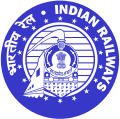
Back سكك الحديد الهندية Arabic ভাৰতীয় ৰে’ল Assamese भारतीय रेल Bihari ভারতীয় রেল Bengali/Bangla Indian Railways Danish Indian Railways German Indian Railways Esperanto Indian Railways Spanish راهآهن هند Persian Indian Railways Finnish
Indian Railways is a state-owned enterprise that is organised as a deparmental undertaking of the Ministry of Railways of the Government of India and operates India's national railway system.[a] As of 2024[update], it manages the fourth largest national railway system by size with a track length of 135,207 km (84,014 mi), running track length of 109,748 km (68,194 mi) and route length of 69,181 km (42,987 mi). As of August 2024[update], 96.59% of the broad-gauge network is electrified. With more than 1.2 million employees, it is the world's ninth-largest employer and India's second largest employer.
In 1951, the Indian Railways was established by the amalgamation of 42 different railway companies operating in the country, spanning a total of 55,000 km (34,000 mi). The railway network across the country was reorganized into six regional zones in 1951–52 for administrative purposes, which was gradually expanded to 18 zones over the years.
The first steam operated railway operated in 1837 in Madras with the first passenger operating in 1853 between Bombay and Thane. In 1925, the first electric train ran in Bombay on DC traction. The first locomotive manufacturing unit was commissioned in 1950 at Chittaranjan with the first coach manufacturing unit set-up at Madras in 1955.
Indian Railways runs various classes of express, passengers and suburban trains. In 2023–4, it operated 13,198 trains on average daily covering 7,325 stations and carried 6.905 billion passengers.[3] Indian Railways also operates different classes of rail freight transport. In 2023–4, it operated 11,724 freight trains on average daily and transported 1588.06 million tonnes of freight.[3] Indian Railways operates multiple classes of rolling stock, manufactured by self-owned coach-production facilities. As of 31 March 2024[update], Indian Railways' rolling stock consisted of 327,991 freight wagons, 91,948 passenger coaches (including multiple unit coaches) and 10,675 electric, 4,397 diesel and 38 steam locomotives.[3]
- ^ "Suneet Sharma Appointed New Chairman and CEO of Railway Board". News18. 31 December 2020. Archived from the original on 13 July 2023. Retrieved 1 December 2023.
- ^ a b "Indian Railways registers record Revenue" (Press release). Business Standard. Archived from the original on 7 June 2024. Retrieved 7 June 2024.
- ^ a b c d e f "Indian Railways Year Book 2023-24" (PDF). Ministry of Railways (Railway Board). New Delhi: Indian Railways Statistical Publications. Retrieved 14 February 2024.
- ^ Status of Railway Electrification (as on 01.02.2025) (PDF) (Report). Indian Railways. Retrieved 17 February 2025.
Cite error: There are <ref group=lower-alpha> tags or {{efn}} templates on this page, but the references will not show without a {{reflist|group=lower-alpha}} template or {{notelist}} template (see the help page).

